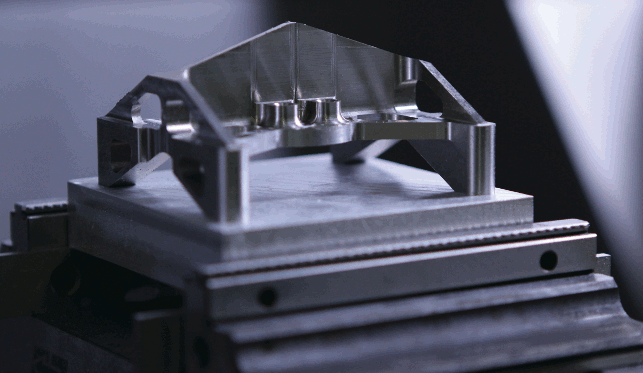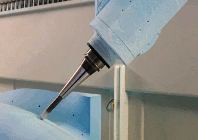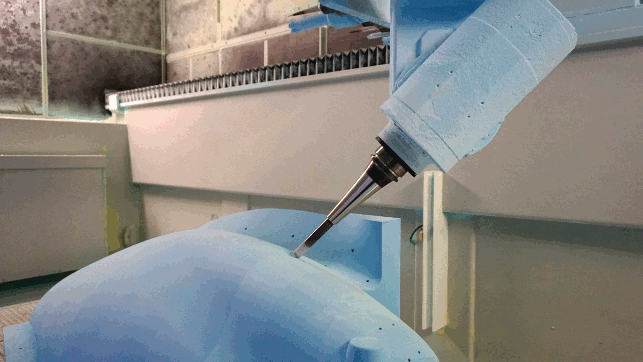
24 hours from CAD to completed component, using five-axis CNC for large scale forming components
Fractions of a second, microns of tolerance: in the exacting world of Formula 1 racing, triumph and failure are only ever a hair’s breadth apart.
With a background in that demanding environment, the two metalwork engineers who founded Freeform Technology in 2008 are acutely aware of the significance of meeting a specification exactly and delivering on time.
Having spotted a market opportunity to apply precision machining methods in the composites field, Simon Burchett and Fred Hutton founded the company in 2008 with just one machine and a collection of hand-me-down tools.
Today, they have five machines, employ a team of more than 20 people and provide a wide range of services to their clients: tooling design and manufacture, pattern and model making, prototyping and design mock-up and full project management of part manufacture.
From the beginning, they knew that they wanted to use NX software from product lifecycle management (PLM) specialist Siemens PLMSoftware.
“We were familiar with NX, we knew it could do the job, and it was one thing we could rely on in the scary days of being a start-up,” comments Burchett. “Just to be sure, we did a benchmark test on other software, but we found that it was just not as good as NX.”
Freeform Technology quickly established a reputation for applying Formula 1 race car standards to the composite tooling industry.
“We deliver an extremely accurate product very quickly,” says Burchett. “Our ongoing business challenge is to maintain that quality and speed as we grow across different industries.”
Consistent quality, fast fulfilment
The company has four floating licences of NX CAM (computer-aided manufacturing), enabling the software to be used by various members of the team.
Well-established as a partner of Siemens PLM Software in the United Kingdom (UK), TEAM Engineering helped Freeform Technology to set up the system and provides ongoing technical support.
“The software is excellent, and the guys at TEAM Engineering are very knowledgeable,” says Hutton. “They are available when we need assistance and always very helpful.”
Freeform Technology’s specialists use a customer’s computer-aided design (CAD) models and material specifications for tooling; or, using 3D laser scanning, they reverse engineer a component design in order to develop and manufacture patterns and tooling.
The engineers check all CAD files thoroughly so that they are correct and optimised for manufacturing. In some cases, they recommend design changes.
With some aspects of CAD included in the NX CAM licences, Freeform Technology’s engineers also have design functionality.
Instead of returning files that require amendment, they save precious time by making modifications on behalf of their customers.
“It’s a huge benefit to have an integrated design and manufacturing package,” notes Jake Oliveira, general manager at Freeform Technology. “We can be very quick.”
Burchett and Hutton have a deep understanding of tooling processes and procedures and, building on that, have developed a range of templates within NX CAM.
These are preset CAM files with predetermined tool settings and cut depths. Similarly, all machines are set up with identical options for tools, tool builds, speeds and feeds.
Providing consistency, these measures also ensure a smooth process when a client’s CAD files arrive, usually in STEP or IGES format.
The majority of Freeform Technology’s business is the manufacture of patterns for carbon fibre components. The turnaround from CAD model to a finished pattern ready for moulding can sometimes be achieved in just 24 hours.
All patterns are custom-made by Freeform Technology, which has a team of dedicated offline programmers. What they write one day will be on the machine later that day or the day after.
The company completes up to 50 patterns a day at its busiest times. It also has the capability to produce aluminium moulds according to customer requirements.
One time-saving feature of NX that is particularly beneficial to Freeform Technology is the capacity to program one side, and then choose to regenerate the model in mirror image.
As most cars have matching left- and right-hand side components, this not only saves programming time, it means that partner components can be loaded on two separate machines at the same time.
Flexibility and control
Because Burchett and Hutton began their business by doing everything themselves, they are particularly aware of the need to maintain the highest quality throughout the tooling process.

Freeform also works at the other end of the spectrum with equally complex, but much smaller components
Here, Burchett particularly values the flexibility of NX. “With some software applications, you simply cannot do what you want to do. I think that’s because purpose-built CAM packages are designed to be used very quickly by anyone.
“They have an easy-to-use interface and, at the click of a button, the machine is off. The trouble with this is that the software drives the toolpaths; the machinist has little control.
“With NX, we have a lot more input into how each tool-path is created.”
This is critical when there are potential issues to address, such as dealing with a complex design that requires the manipulation of toolpaths in order to remove as much material as efficiently possible.
A single source of data
“Serving the Formula 1 industry has its drawbacks. Pressure is particularly intense in the run-up to the racing season as teams finalise designs. As we mature, [we’re doing] business more on our own terms, and we are using NX to support diversification,” notes Burchett.
Freeform Technology’s strategy is to continue growing the business in motorsports and respond to demand from new sectors, such as aerospace, defence, energy, leisure, marine, medical, and oil and gas.
Although existing clients supply their own data, the two directors offer additional services, including powerful design services using NX CAD.
“Previously, we subcontracted to specialists when clients needed significant CAD input, but it is more efficient to bring it in-house, especially for complex designs. We have more control over the manufacturing process and can focus on reducing our clients’ costs.”
For Burchett, the key is to expand without losing focus on quality and delivery, because these are what have underpinned the company’s success and growing reputation.
The next step is to implement Teamcenter for complete lifecycle management. Together, they will help us stay on top, as well as see what else we can offer,” he says.
Because speed of response is so critical, TEAM Engineering has prepared a deployment plan for Freeform designed to take just five days: two days of implementation and three days of training.
Burchett notes, “Our ultimate goal is to be a paperless company, with a single source of digital data that everyone shares for design, tooling and shop documentation, so whenever we update a tool-path we are all working on the latest data,” he says.
“Having NX as our PLM platform means we can extend our capability. In the future, we may also look at analysing components.”
Hutton summarises, “Being a customer of Siemens PLM Software gives us an opportunity to stay ahead of the game with regard to our competition. We can consistently offer our customers the very best quality, absolute accuracy and the tightest turnaround time.”

5-axis machining for F1 is at the top of its game
Default






